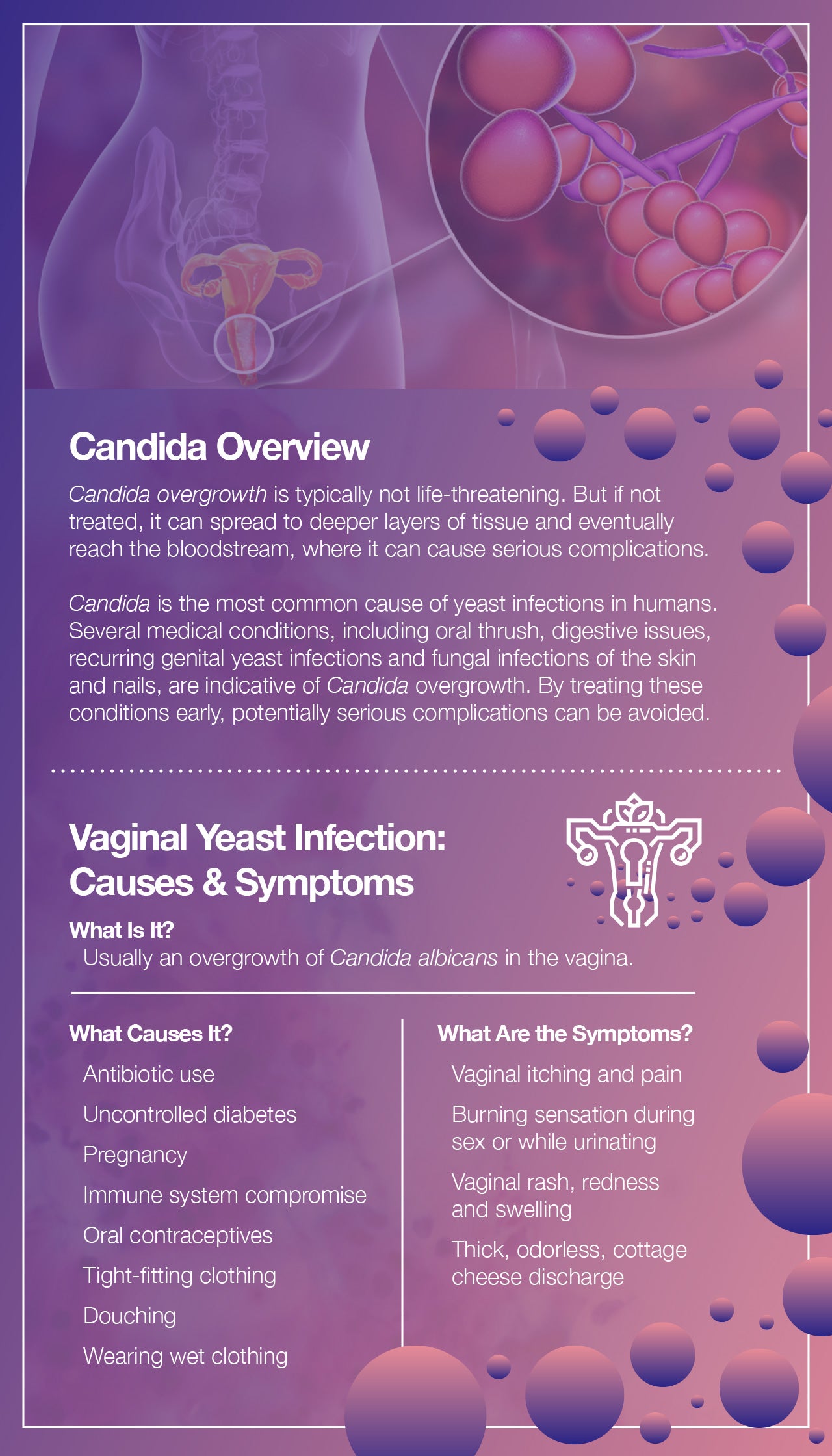Candida Overgrowth: Signs You Have a Yeast Infection—And How to Get Rid of It
 By: by Amino Science
By: by Amino Science

Yeast are one-celled fungi that help bring us many of the things we love, like leavened bread and beer. But did you know that yeast can also bring disease? And one type of yeast, Candida, is particularly notorious for its ability to cause infection. The genus Candida is made up of hundreds of species, including Candida albicans—the most common cause of fungal infections. Yet everyone has Candida living in (and on) their body, all the time. It’s only when something happens to throw off the body’s balance that Candida overgrowth occurs. But what causes this overgrowth, and what can we do to stop it?
In this article, we’re going to take a closer look at this common yeast and discuss the signs and symptoms of Candida overgrowth and the steps you can take to bring your body—and your health—back into balance.
What Causes Candida Overgrowth?
As mentioned, C. albicans is the most common cause of fungal infections. However, it’s also a normal part of the flora of the human body and can be found in small numbers on the skin and mucous membranes, including the mouth and genitourinary and gastrointestinal tracts.
Most of the time, healthy bacteria and the body’s immune system keep levels of Candida yeast in check. But Candida is also an opportunistic pathogen whose numbers can balloon out of control under the right circumstances. Factors such as antibiotic use, uncontrolled diabetes, immune compromise, and oral contraceptive use can all cause an overgrowth of Candida.
Interestingly, Candida overgrowth can also result in a vicious cycle in which imbalances in the body lead to overgrowth of the yeast and increased numbers of the yeast lead to yet more imbalances and health problems.
Candida Overgrowth and Your Health
A number of medical conditions are associated with Candida overgrowth, or candidiasis. These include:
- Oral thrush
- Skin and nail fungal infections
- Immune system compromise
- Gut bacteria imbalance
- Chronic sinus infections
- Bone and joint conditions
- Genitourinary infections
Oral Thrush
An overgrowth of Candida albicans in the mouth can lead to a condition known as oral thrush. Recognizable by its classic symptom of creamy white, cottage cheese–like lesions on the tongue, cheeks, and sometimes throat (where it’s called esophagitis), oral thrush is often seen in people with weakened immune systems, though poor oral hygiene and dentures can increase your risk as well.
Skin and Nail Fungal Infections
Under certain circumstances, the C. albicans that naturally lives on the skin can become invasive and lead to infections of both the skin and nails. The infection is most likely to be seen in the skin folds, where moisture content is highest—for example, the armpits and groin and beneath the breasts. However, infections of the nails may also occur.
Immune System Compromise
Candida infections frequently occur when the immune system becomes weakened. One study suggests that candidiasis of the gastrointestinal tract may even lead to chronic fatigue syndrome. The authors of the study describe evidence indicating that Candida overgrowth depresses the activity of T cells and natural killer (NK) cells, both of which are necessary to prevent reactivation of the viruses linked to chronic fatigue.
Gut Bacteria Imbalance
Both good and bad bacteria live in the digestive tract. The good bacteria aid nutrient absorption by processing carbohydrates, fibers, and sugars and support gut health by defending the body against invading microbes.
However, if the ratio of good to bad bacteria is thrown off and the bad bacteria begin to outweigh the good, a multitude of digestive issues can result. Common symptoms of an imbalance in gut bacteria may include:
- Bloating
- Constipation
- Diarrhea
- Nausea
- Gas
- Cramps
A 2011 study published in the journal Current Opinion in Microbiology links an overgrowth of Candida to health issues like ulcerative colitis and Crohn’s disease. Study researchers also point out that prior studies have shown that high levels of Candida delay healing of “inflammatory lesions,” and that “inflammation promotes colonization.”
In other words, a vicious cycle can be created in which inflammation promotes the growth of Candida and the growth of Candida promotes inflammation.
Moreover, the disruption of the intestinal mucosa that characterizes leaky gut syndrome can allow Candida to leak into the bloodstream, where it can lead to a serious infection called invasive candidiasis. This disease can affect every part of the body, including the heart and brain, and may be life-threatening.
Chronic Sinus Infections
According to the Centers for Disease Control and Prevention (CDC), approximately 33 million Americans suffer from chronic sinus infections (sinusitis), defined as inflammation and swelling of the sinuses that last for 3 months or more.
With symptoms such as headache, runny nose, nasal congestion, and impaired ability to taste and smell, sinusitis can make life miserable. What’s more, repeated bouts of chronic sinusitis can lead to nasal polyps.
While most short-term sinus infections are caused by bacteria, fungi have been implicated in a significant number of chronic sinus infections. In fact, a study performed by researchers at the Mayo Clinic of 210 people with chronic sinusitis found that 96% had fungi in their mucus.
Bone and Joint Conditions
Candida overgrowth can lead to a condition known as Candida arthritis, which usually affects the knees, hips, and shoulders and can cause joint pain, tenderness, and swelling. Interestingly, a study conducted by the International Osteoarticular Mycoses Consortium found that the majority of patients with this form of Candida infection do not have any pre-existing immune system problems.
Another serious complication of Candida overgrowth is osteomyelitis—a bone infection that can also cause pain, tenderness, and swelling. According to a 2012 study, this chronic form of invasive candidiasis is being reported with greater frequency.
Genitourinary Infections
Like other mucous membranes, the vagina normally contains a mix of both bacteria and yeast, including Candida. But an overgrowth of Candida can lead to vaginal candidiasis. Yeast overgrowth in the vagina can be the result of a number of factors, including antibiotic and oral contraceptive use—which can alter vaginal pH—as well as pregnancy and uncontrolled diabetes.
According to the CDC, vaginal candidiasis is the second most common type of vaginal infection, with bacterial vaginal infections leading the charge. In fact, approximately 75% of women will have at least one yeast infection during their lifetime.
Symptoms of vaginal candidiasis include itching, burning, redness, swelling, pain, rash, and cottage cheese discharge. Sometimes these symptoms can be severe and lead to cracking or tearing of the vaginal mucosa.
While genital yeast infections are more common in women, men can get them too—in the form of balanitis, or inflammation of the head of the penis. Like vaginal yeast infections, balanitis is more likely to occur in men with uncontrolled diabetes or after antibiotic use. Men who are uncircumcised or have sex with a female partner who has a vaginal yeast infection are also at risk.
Symptoms of balanitis may include moist skin, redness, itching, burning, and skin folds with thick, white material.
Candida overgrowth can cause urinary tract infections (UTIs) as well. In fact, C. albicans is the most common cause of fungal infections of the urinary tract that occur during hospitalization.

How to Treat (and Prevent) Candidiasis
If you’ve been diagnosed with candidiasis, first-line treatment will involve the use of antifungal medications. However, the form used will depend on the type of infection you have.
For example, liquid nystatin may be used as a medicated mouthwash for oral thrush, while a vaginal yeast infection may be treated with creams or suppositories and cutaneous candidiasis may be treated with powders. In the case of more severe infections, oral antifungals may be used.
In addition, a 2014 study found that eating plenty of foods that balance gut bacteria is an important consideration in preventing recurrent Candida infections.
A Candida diet high in garlic, coconut oil, curcumin, xylitol, aloe vera, pomegranate, fermented foods like kombucha, and probiotics and low in refined sugars, carbohydrates, and high-lactose dairy products may also help maintain normal levels of Candida.
A recent study also found that a component of coconut oil called caprylic acid inhibits the virulence of Candida and may be effective in the treatment of yeast infections caused by C. albicans.
To further aid healing and help prevent recurrence of Candida, a number of preventative measures are also recommended. These include:
- Wearing breathable underwear
- Wearing loose-fitting clothing
- Avoiding wearing wet clothing for long periods of time
- Avoiding hot tubs and very hot baths
- Maintaining good hygiene
- Avoiding douching
- Minimizing antibiotic use
- Boosting your system with amino acids
If you’re suffering from the symptoms of candidiasis, be sure to speak with your health care provider right away. The sooner the infection is treated, the easier it is to cure and the less chance there is of it progressing to a more serious infection with potentially life-threatening complications.

Up to 25% off Amino
Shop NowTAGS: conditions
Join the Community
Comments (0)
Most Craveable Recipes




 833-264-6620
833-264-6620



















